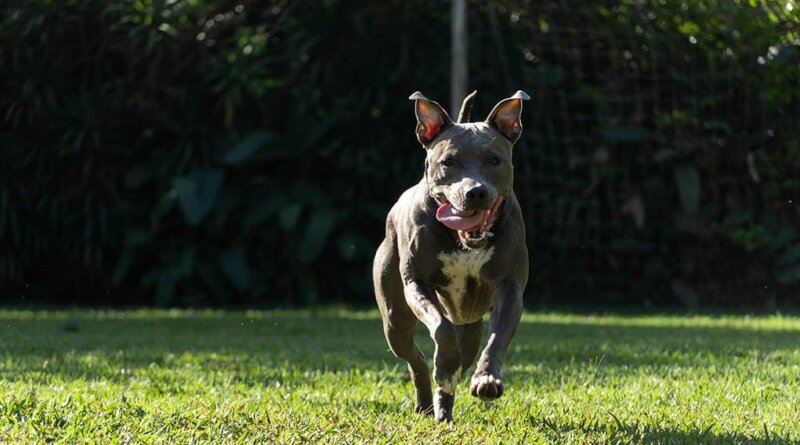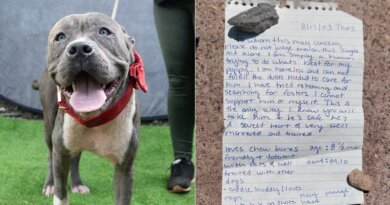Blue Nose Pitbull Dog Breed Profile – Top Dog Tips

Nowadays, there are so many variations of dog breeds you might think that a new breed is coming to life every day.
That’s why you might not even hear of the Blue Nose Pitbull.
The Blue Nose Pitbull is a color variation in the American Pitbull Terrier breed.
Or maybe you just thought a dog with a blue nose was not a big deal.
But the truth is, the blue-nose is a rarity in most dogs and among American Pit Bull Terriers.
So now you might be wondering, what is a Blue Nose Pitbull?
Luckily for you, if you plan to adopt a Blue Nose Pitbull puppy, this blog will tackle everything you need to know about the unique breed.
However, many people still have mixed feelings about Pitbulls since many misconceptions exist.
Pitbulls have bad reputations because of the past misuse of this strong breed.
They were once used for bullbaiting, but if you’ve been around pit bulls, you’ll know that these dogs are actually affectionate and loyal dogs that make excellent family pets.
So what’s the difference between an American Pit Bull from a Blue Nose Pitbull?
Well, you better scroll down to find out!
Below, we’ll tackle the breed’s appearance, temperaments, training needs, and more.
Blue Nose Pitbull History
As discussed briefly above, Pitbulls have a bad reputation as aggressive dogs.
This unfortunate misconception has caused them to be outlawed in many different countries, including some states in the U.S.
American Pit Bull Terriers were created in the 19th century in England.
They were made by breeding Bulldogs and English terriers.
These dogs arrived in America around 1845 to 1860, where they were used for fighting.
Like other pit bull terriers, Blue Nose Pitbulls are strong and muscular and primarily used for bull and bear hunting.
Moreover, The American Kennel Club (AKC) recognizes the American Pit Bull Terrier as a breed but does not recognize the Blue Nose Pitbull.
Blue Nose Pitbull Physical Characteristics
The Blue Nose Pitbull looks just like other types of Pitbulls, except for its color.
Their body is athletically built with a muscular physique.
Pitbulls are considered medium-sized dogs.
But they look very large since they weigh around 30 to 60 pounds. They are also about 17 to 21 inches tall.
Blue Nose Pitbulls have short, smooth coats that need low-maintenance grooming.
However, they do shed during their shedding season.
The dog’s most notable feature is, of course, its color. The unique, beautiful bluish-grey hue is found in their coat, nose, eyes, skin, and toenails.
Some Blue Nose Pitbulls can have white markings on their chest, similar to other Pitbulls with fascinating colors, like the Red Nose Pitbull.
“Wait, there are also Red Nose Pitbulls?”
Yup! Later on, we’ll discuss their differences.
Blue Nose Pitbull Temperament
Blue Nose Pitbulls, despite having a bad reputation for being aggressive, are actually affectionate pets, just like all Pitbull terriers.
They are excellent family pets known to be very gentle with children.
These dogs are loving, playful, and loyal.
They always want to be beside their human as they develop a strong bond with their owners.
But this can be a problem if you’re at work most of the time.
All it takes is to properly socialize, exercise, and train your pup so that you can avoid behavioral problems in the future.
Exercising and training your Blue Nose Pitbull can prevent boredom.
A bored dog will make his fun. And their kind of fun is not the same for us humans.
For instance, they’ll chew furniture and shoes, destroy pillows, or unroll your toilet paper.
Living with a Blue Nose Pitbull
Blue Nose Pitbulls need lots of love and attention.
If you’re the type of owner that is busy all the time, this might not be the dog breed for you.
Also, most Pitbull terriers tend to prefer humans over other pets.
Not all Ptbulls get along well with other dogs, but they can if they are properly introduced or grow up together.
As discussed above, Blue Nose Pitbulls are excellent family dogs known for being gentle with children.
They are active and love to play.
Training
Blue Nose Pitbulls are highly intelligent dogs.
However, that means that they can also be a bit stubborn. That’s why it’s advised to start training at an early age.
Blue Nose Pitbulls respond well to positive reinforcement. Never use force or punishment-based dog training, as it only worsens things.
Training is an essential aspect of owning a dog. It is important to any breed.
Even though this dog breed has a bad reputation for being aggressive, trained Pitbulls are great companions.
Training helps them to become well-rounded dogs, making them affectionate and caring pets that are far from being aggressive.
And just like training, socializing your Pitbull is a young age is a great technique for them to do well with other dogs and pets.
Expose them to different sights, sounds, environments, and experiences when they’re young to help them make a well-rounded dog.
Exercise
Blue Nose Pitbulls are athletic and active dogs. They have tons of energy!
They love to play and explore. They love pulling games so that you can try the good ol’ classic tug-of-war.
Aim for at least 1 to 2 hours of exercise daily, preferably spread over at least two periods.
If you love to go hiking or jogging, you can bring Fido along for their daily exercise.
But remember that some places require Pitbulls to be always kept on a leash in public areas.
Blue Nose Pitbulls can also engage in agility sports.
With their flexibility and energy, agility courses are perfect for these dogs.
Blue Nose PitBull Health Care
The Blue Nose Pitbull is a healthy dog breed. Their life expectancy is about 8 to 15 years!
Sadly, these dogs can be prone to health problems like any other breed.
When it comes to adopting dogs, it’s best advised to adopt from a reputable breeder, ensuring you’re getting a healthy dog.
Responsible breeders know never to breed dogs that are suffering from genetic conditions.
Owners should schedule regular visits to the veterinarian to keep their health in check.
Cataracts
A cataract is an obstruction of lens fiber in the lens of an eye. The gradual clouding of the lens in the eyes.
Although this is more common in elderly dogs, it can also be acquired through genetics, traumatic eye injuries, nutritional deficiencies, or diabetes.
Have your pet undergo an ophthalmic examination to detect small cataracts as early as four to five.
To determine whether it is blinding, it is better to check with your veterinarian to be informed what procedure should be done.
Heart Issues
One of the dogs’ most common heart problems is Aortic Stenosis, a hereditary heart problem.
It’s an abnormal narrowing of the connection between the left ventricle and the aorta.
Be aware because some dogs will only show minor signs.
Schedule your pup for a checkup regularly. A chest x-ray and an electrocardiogram can help confirm the diagnosis.
Hip Dysplasia
Hip dysplasia is a hereditary condition wherein the socket of the joint and ball becomes deformed.
Due to their large stature, their mass stresses their lower body areas, especially in their joints.
When diagnosed with hip dysplasia, it’s essential to keep their weight in the normal range and have them exercise with activities that promote joint therapy.
Veterinarians may prescribe medications for anti-inflammatory, pain relievers, and supplements.
Elbow Dysplasia
Like hip dysplasia, elbow dysplasia is a hereditary condition.
One possible cause of this condition is the different growth traits of the three bones that make up their elbow.
Dogs suffering from elbow dysplasia will suffer from painful lameness.
Your vet can recommend surgery to treat and correct the problem and will suggest your pup take medication to control the pain.
Progressive Retinal Atrophy
Progressive Retinal Atrophy, or PRA, is another health condition the Blue Nose Pitbull is prone to.
This condition affects the rod and cone cells in the eyes, leading to blindness.
Sadly, this disease can progress quickly from a year or two.
It is also a hereditable disease known to have no treatment yet.
Having your dog’s eyes frequently checked is best advised to reduce the risk of PRA.
Allergies
Although it’s uncommon for American Pit Bull Terriers and Blue Nose Pitbulls, some have allergies.
Owners should also ask their veterinarian what causes the allergy and what foods or activities to avoid.
Deafness
Deafness in dogs can be caused by trauma, infection, or other underlying diseases, or it can be congenital.
Although it isn’t as prevalent with other breeds, deafness can be hereditary.
If the owner suspects their Blue Nose Pitbull is deaf, they should have it checked and tested by their veterinarian.
There, they will be able to figure out if it’s bilateral or not and the grade of deafness with their dog.
Disabled dogs may require more assistance but do not mean they will do less for their owners.
Blue Nose Pitbull Grooming Needs
Blue Nose Pitbulls have short, smooth coats that require low-maintenance grooming as they only require minimal brushing.
Brush your Blue Nose Pitbull’s coat weekly to help remove loose fur and maintain its beautiful coat.
They only need to be bathed when they are dirty or have a strong odor.
If your pup loves to play outside or roll around dirt, bathe them afterward.
Keeping their nails short by trimming them regularly is very important.
When trimming their nails, a good rule is never to let them touch the ground.
To avoid dental problems, regular teeth cleaning is advised.
You can also do it daily to prevent tartar buildup and remove bacteria lurking inside their mouths.
Blue Nose Pitbulls are prone to ear infections. Check for dirt and debris, leading to prevent this health issue.
Check your dog’s ears regularly. Clean them with a damp cloth or a dog-specific ear-cleaning solution.
Also, keep an eye out for their skin as they are prone to allergies.
For instance, watch out for skin allergies and irritations. Monitor their skin for signs of redness, rashes, or itching.
If you notice any issues, consult with your veterinarian for appropriate treatment.
Frequently Asked Questions
Are Blue Nose Pitbulls aggressive?
No, Blue Nose Pitbulls are loyal and very affectionate dogs. With proper training and socialization, these are not aggressive dogs.
They are known to be gentle with kids making them great family dogs. They are most likely to play with intruders than to attack them.
Are Blue Nose Pitbulls good family dogs?
Yes, the Blue Nose Pitbull is playful and a great family dog. These dogs are sometimes even called “nanny dogs” due to their loving and gentle care for children.
However, some Pitbulls may not get along well with other dogs or other pets, especially if they are not trained and socialized at a young age.
Are Blue Nose Pitbulls rare?
The Blue Nose Pitbull is one of the color variations within the American Pit Bull Terrier breed. Their color came from a recessive gene, making them rare dogs.
However, the rarest Pitbulls are the tri-color Pitbulls. These dogs have coats that have three different colors.
Blue Nose Pitbull Dog Breed Profile: Before You Go…
The Blue Nose Pitbull is a unique color variation within the Pitbull Terrier family.
They are energetic and athletic dogs. They have a strong and muscular build. Besides their beautiful, rare coloring, the Blue Nose Pitbull is a loving and loyal breed.
Like any other dog, the Blue Nose Pitbull will benefit from early socialization and proper training. They can be well-mannered and friendly with people and other animals.
Blue Nose Pitbulls, generally, are caring, loyal, and affectionate towards their owners. They often display a high level of intelligence and can be eager to please.
They are known to be good family dogs, often displaying patience and gentleness with children.
RELATED ARTICLES:









